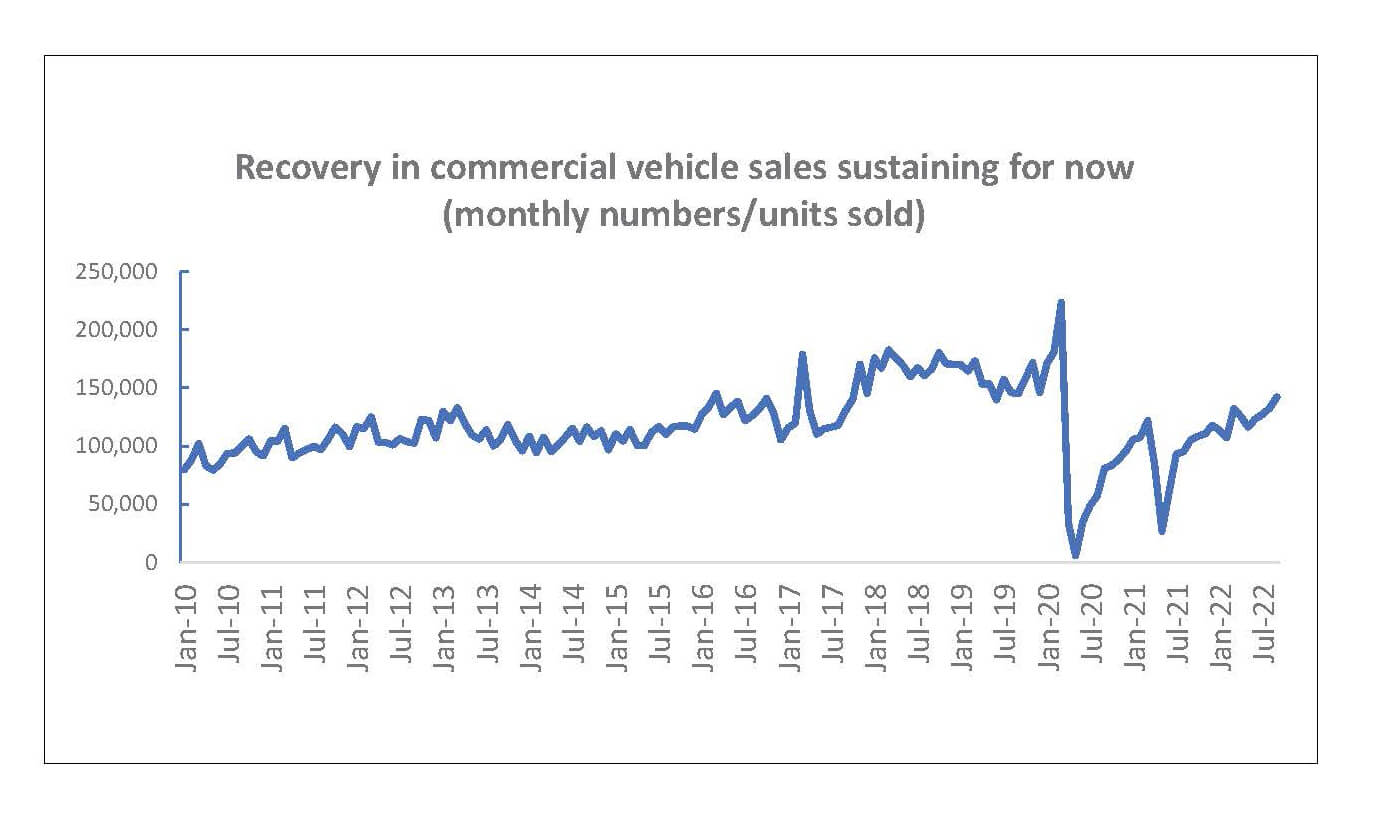
Macro and
Equity Market
Outlook
Equity Market
Outlook
Global Macro & Markets - Oct 2022
Indian markets rose in October in line with major global markets, albeit at a slower pace than global peers. Major indices broadly rose over the month, except for MSCI EM (-3.2%) and the Hang Seng (-14.7%). The S&P500 (8.0%), the Euro 50 (9.0%), the MSCI
World (7.1%) and the Nikkei (6.4%) witnessed rises after falling in the previous month. Additionally, NIFTY 50 India, BOVESPA Brazil, and MOEX Russia all rose 5.4%, 5.5% and 10.7% MoM. LME Metals Index witnessed a fall
of -1.5% MoM owing to a broad-based softening of demand, as well as a stronger US$. Brent crude rebounded 8.8% MoM. Dollar index fell marginally by -0.5% over the month. US, India, and Germany 10Y G-Sec rates were up by
22, 5 and 3 bps MoM and settled at 4.05%, 7.45% and 2.14%, respectively.
Domestic Macro & Markets - Oct 2022
SENSEX rose 5.8% in October. Mid-cap and small-cap indices underperformed large-cap and were up 2% and 1.3% respectively. Of the sectoral indices, Bank, Capital Goods, and IT indices outperformed the Sensex, with only the FMCG index falling MoM (-0.2%).
Market breadth improved over the month with 83% of Sensex stocks trading above their respective 200-day moving averages on November 1st, 2022. FII participation was near net-zero in October, with FPI outflows of $5.2mn,
following a $1.6bn outflow in September. So far, India has seen YTD (Year to date) FII outflows of $22.6bn. DIIs saw buying of $1.3bn in October, with YTD inflows of $33.8bn. Mutual funds and Insurance funds were both net
buyers in September 2022 with $0.9bn inflows and $0.3bn inflows respectively.

India's high frequency data update:
Sustained high levels of GST collections, strengthening, but moderating core, manufacturing & agricultural sector outputs, moderating wholesale inflation and accelerating credit growth augured well for the Indian economy.
Manufacturing PMI:
Manufacturing PMI rose MoM in October’22, reaching 55.3, and remained in expansion zone (>50 points) for the 16th straight month, with a solid increase in new orders, inventories, and output. Hiring by manufacturers reached a 33-month high.
GST Collection:
The second highest ever collections of INR 1.52 Tn (+17% YoY) in October’22 concluded the eighth consecutive month of collections over 1.4Tn mark, with improving tax compliance and healthy festive season economic activity driving the sustained and rising
collections.
Core sector production:
Core sector production expanded to a 3-month high of +7.9% YoY in September’22, owing to the festival surge and an acceleration in output growth of steel, and coal.
Industrial Production:
Manufacturing IIP contracted by -0.7% YoY in August’22 vs a 2.2% rise in July’22, after the combined headwinds of global hawkishness, pressure on exports and base effect normalization played a role to sober industrial output.
Credit growth:
Credit growth accelerated to 16.75% YoY as of 7-October 2022 against YoY growth of 6.49% as observed on 8-October 2021.
Inflation:
CPI inflation in September’22 increased to a five-month high of 7.41% from 7% in August’22 led by broad based food price rises. WPI inflation continued its dip in September’22 fell 171bps MoM to 10.70%.
Trade Deficit:
Indian imports in September’22 grew 13.74% YoY to $64.02 Bn, while Exports rose to $36.9 Bn, at a rate of 9.21% YoY. Trade Balance for the month of September’22 stood at -$27.09 Bn.
Government fiscal position under control in 1HFY23:
The centre’s fiscal deficit narrowed for 1HFY23 to be INR 6.2Tn, or 37.3% of the full-year Budget Estimate (BE) of INR 16.6Tn, up from 35% in the same period last year. Key points from the CGA’s release were: a) The centre remains confident of keeping
the fiscal deficit at 6.4% of nominal GDP in FY23, as it spends more on fertiliser, fuel, and food subsidies. B) Total Expenditure reached 46.2% of its budget target, at Rs. 18.24Tn, 12% up YoY C) Net Tax Revenue during
10.11Tn, 9.9%yoy, and at 52.3% of this year’s BE. D) Capital expenditure was 45.7% of the full-year budget objective in the current fiscal, compared to 41.4% in the similar period last year. E) Interest payments accounted
for Rs. 4.36Tn of total revenue spending, nearly 25% of total Govt spending.
Market View
Inflation remains reasonably elevated across geographies and in response global Central Banks continued to hike interest rates. Weakness in US, Europe and China can impact global demand on account of rising Inflation and geography specific issues like
Covid/policy changes in China. However, on positive note the growth concerns have led to cool off in the commodity prices including crude, which bodes well for India.
Domestic high frequency indicators remained resilient despite the global headwinds underlining the domestic recovery possibilities. Policy reforms, huge under investments in Capex, stronger corporate Balance Sheets alongside a transition to a multipolar
world may aid manufacturing, exports and capex - creating a virtuous cycle of growth. However, the anticipated global slowdown, rising energy & interest costs may lead to higher than usual volatility especially in the short
run.
We are attempting to maintain balanced portfolios through a combination of domestic recovery themes along with secular businesses. The attempt is to identify relatively better valued opportunities across these themes.
From an investor’s perspective given the external risks and its potential impact investing in a staggered manner or systematic route may help iron out market extremes. Given our view that broader markets can do well with the present fundamentals, long-term
investors can consider diversified strategies like multi-cap or flexi-cap offerings for pure equity investments. Conservative investors seeking equity exposure with lower volatility may consider asset allocation strategies
like - Balanced Advantage/Asset Allocator which manage equity allocations dynamically.
Note:The sectors mentioned are not a recommendation to buy/sell in the said sectors. The schemes may or may not have future position in the said sectors. For complete details on Holdings & Sectors of NIMF
schemes, please visit website mf.nipponindiaim.com.
Past performance may or may not be sustained in future
Past performance may or may not be sustained in future
Chart of the month :
India’s commercial vehicles registered strong growth, accelerating at 35.2% YoY (September 2022).

Common Source:
CMIE, Nippon India Mutual Fund Research, Bloomberg
Disclaimer:The information herein above is meant only for general reading purposes and the views being expressed only constitute opinions and therefore cannot be considered as guidelines, recommendations
or as a professional guide for the readers. The document has been prepared on the basis of publicly available information, internally developed data and other sources believed to be reliable. The sponsors, the Investment
Manager, the Trustee or any of their directors, employees, Associates or representatives (‘entities & their Associate”) do not assume any responsibility for, or warrant the accuracy, completeness, adequacy and reliability
of such information. Recipients of this information are advised to rely on their own analysis, interpretations & investigations. Readers are also advised to seek independent professional advice in order to arrive at an
informed investment decision. Entities & their associates including persons involved in the preparation or issuance of this material, shall not be liable in any way for any direct, indirect, special, incidental, consequential,
punitive or exemplary damages, including on account of lost profits arising from the information contained in this material. Recipient alone shall be fully responsible for any decision taken on the basis of this document.
